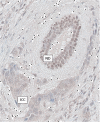Germline mutation in the RAD51B gene confers predisposition to breast cancer
- PMID: 24139550
- PMCID: PMC4016303
- DOI: 10.1186/1471-2407-13-484
Germline mutation in the RAD51B gene confers predisposition to breast cancer
Abstract
Background: Most currently known breast cancer predisposition genes play a role in DNA repair by homologous recombination. Recent studies conducted on RAD51 paralogs, involved in the same DNA repair pathway, have identified rare germline mutations conferring breast and/or ovarian cancer predisposition in the RAD51C, RAD51D and XRCC2 genes. The present study analysed the five RAD51 paralogs (RAD51B, RAD51C, RAD51D, XRCC2, XRCC3) to estimate their contribution to breast and ovarian cancer predisposition.
Methods: The study was conducted on 142 unrelated patients with breast and/or ovarian cancer either with early onset or with a breast/ovarian cancer family history. Patients were referred to a French family cancer clinic and had been previously tested negative for a BRCA1/2 mutation. Coding sequences of the five genes were analysed by EMMA (Enhanced Mismatch Mutation Analysis). Detected variants were characterized by Sanger sequencing analysis.
Results: Three splicing mutations and two likely deleterious missense variants were identified: RAD51B c.452 + 3A > G, RAD51C c.706-2A > G, RAD51C c.1026 + 5_1026 + 7del, RAD51B c.475C > T/p.Arg159Cys and XRCC3 c.448C > T/p.Arg150Cys. No RAD51D and XRCC2 gene mutations were detected. These mutations and variants were detected in families with both breast and ovarian cancers, except for the RAD51B c.475C > T/p.Arg159Cys variant that occurred in a family with 3 breast cancer cases.
Conclusions: This study identified the first RAD51B mutation in a breast and ovarian cancer family and is the first report of XRCC3 mutation analysis in breast and ovarian cancer. It confirms that RAD51 paralog mutations confer breast and ovarian cancer predisposition and are rare events. In view of the low frequency of RAD51 paralog mutations, international collaboration of family cancer clinics will be required to more accurately estimate their penetrance and establish clinical guidelines in carrier individuals.
Figures



References
-
- Miki Y, Swensen J, Shattuck-Eidens D, Futreal PA, Harshman K, Tavtigian S, Liu Q, Cochran C, Bennett LM, Ding W, Bell R, Rosenthal J, Hussey C, Tran T, McClure M, Frye C, Hattier T, Phelps R, Haugen-Strano A, Katcher H, Yakumo K, Gholami Z, Shaffer D, Stone S, Bayer S, Wray C, Bogden R, Dayananth P, Ward J, Tonin P. et al.A strong candidate for the breast and ovarian cancer susceptibility gene BRCA1. Science. 1994;13:66–71. doi: 10.1126/science.7545954. - DOI - PubMed
Publication types
MeSH terms
Substances
LinkOut - more resources
Full Text Sources
Other Literature Sources
Medical
Research Materials
Miscellaneous

